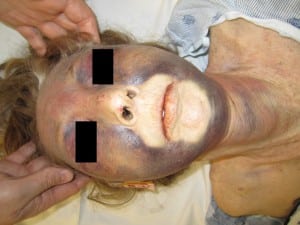| Author | Affiliation |
|---|---|
| Joseph R. Shiber, MD | University of Florida, College of Medicine Jacksonville, Department of Emergency Medicine, Jacksonville, Florida |
| Emily Fontane, MD | University of Florida, College of Medicine Jacksonville, Department of Emergency Medicine, Jacksonville, Florida |
| Brett Monroe, MD | University of Florida, College of Medicine Jacksonville, Department of Emergency Medicine, Jacksonville, Florida |
A 51 year-old woman was found confused while crawling across a field. She had marked facial cyanosis and edema with cutaneous petechiae, subconjuctival hemorrhages, and echymosis across her anterior neck (image 1). Mild cerebral edema and a non-displaced thyroid cartilage fracture were found on computed tomography (CT). The patient recovered full neuro-cognitive function within 24 hours and reported that she had been assaulted and choked by the throat. Her airway remained stable and the laryngeal injury was treated conservatively; she was discharged home after three days.
Olivier described this syndrome over 150 years ago after thoraco-abdominal crush injuries. It is essentially a prolonged valsalva maneuver that results in increased venous pressure and stasis above the level of the compressive force.1,2 The consequent findings on the chest, neck and face are startling but of no prognostic significance, and the majority of patients have a favorable outcome.2,3
Footnotes
Address for Correspondence: Joseph R Shiber, MD, University of Florida, College of Medicine Jacksonville, 1st Floor, Clinical Center, 655 West 8th Street, Jacksonville, FL 32209. Email: joseph. shiber@jax.ufl.edu. 11 / 2013; 14:653 – 653
Submission history: Revision received June 16, 2013; Accepted July 1, 2013
Conflicts of Interest: By the WestJEM article submission agreement, all authors are required to disclose all affiliations, funding sources and financial or management relationships that could be perceived as potential sources of bias. The authors disclosed none.
REFERENCES
1. Jongewaard W, Cogbill T, Landercasper J Neurologic consequences of traumatic asphyxia. J Trauma. 1992; 32:28-31
2. Sarihan H, Abes M, Akyazici R Traumatic asphyxia in children. J Cardiovasc Surg. 1997; 38:93-5
3. Richards C, Wallis D Asphyxiation: a review. Trauma. 2005; 7:37-45



